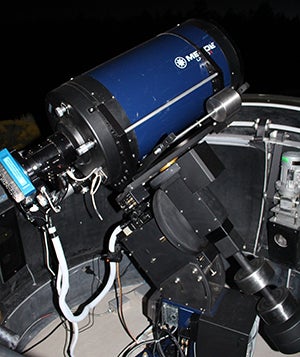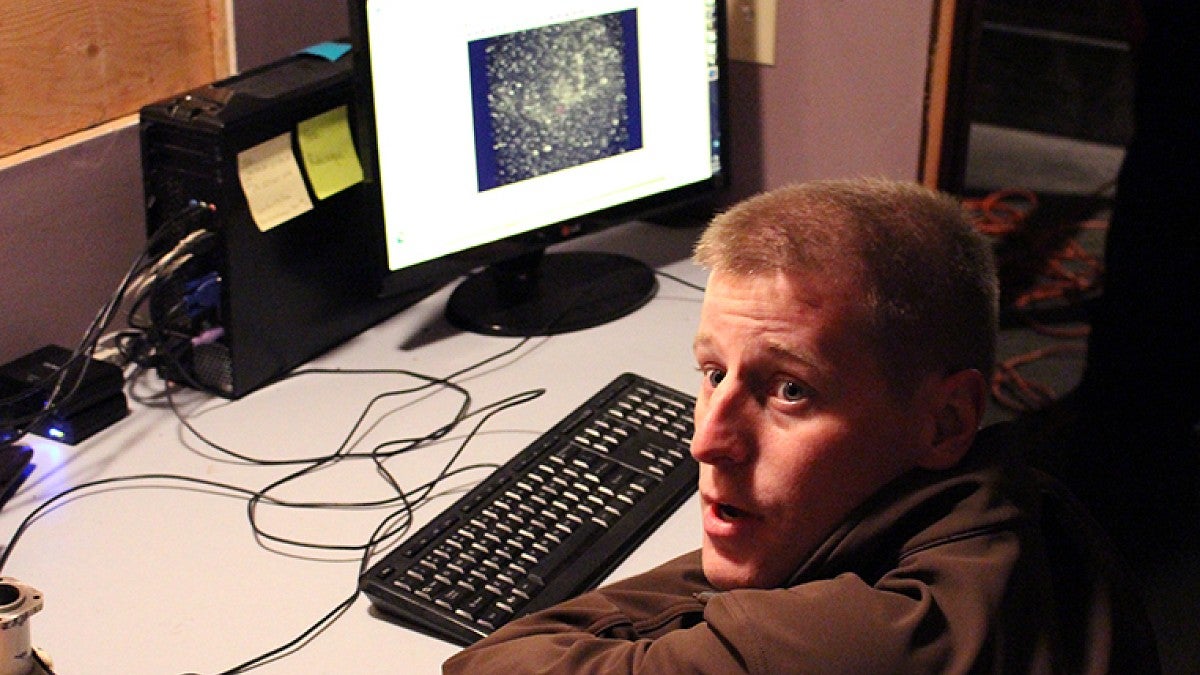The UO’s Pine Mountain Observatory was the star of the show last week, which isn’t bad considering that the co-stars were Altair, Vega, the Ring Nebula and the planet Saturn.
The observatory, on a lonely High Desert hilltop east of Bend, opened the domes over its four telescopes for a gathering of Oregon NASA Space Grant participants Sept. 11. More than a dozen students and teachers from around the state trekked to the observatory for a chance to peer through an eyepiece at some of the wonders of the heavens.
“It’s fantastic,” said Parker Swanson, a computer science instructor at Linn-Benton Community College who also advises the school’s Space Club. “We’re just fascinated with what they can do up here.”
The show-and-tell gathering was a chance for UO scientists and students to show off the observatory’s latest addition, a new telescope with a 14-inch mirror that can be operated remotely from a computer in Willamette Hall on the main campus in Eugene. Or from just about anyplace else, for that matter.
A donation from longtime Pine Mountain benefactor Ken Robbins funded the dome, the telescope and its cameras and automatic drive. The Astro Haven clamshell dome was named for Robbins in recognition of the gift.
 Building and installing the remote-control system was the job of UO physics undergraduate Jeremy Bullis. With help from observatory research associate Allan Chambers, Bullis spent the past summer rigging the new system so the dome can be opened, the telescope pointed and images taken with a few strokes on a keyboard.
Building and installing the remote-control system was the job of UO physics undergraduate Jeremy Bullis. With help from observatory research associate Allan Chambers, Bullis spent the past summer rigging the new system so the dome can be opened, the telescope pointed and images taken with a few strokes on a keyboard.
“It feels great, once it really works,” Bullis said. He’s been working out the usual laundry list of technical bugs that seem to crop up in any complex system, but telescope is online and close to taking its first image.
Bullis is working with Scott Fisher, the director of undergraduate studies in the UO physics department, to get the telescope ready for actual research. Fisher, who worked at the Gemini Observatory on Hawaii’s Mauna Kea before coming to the UO, hopes to make the new telescope part of an outreach program involving students in K-12 schools, community colleges and universities around the state.
“At this point all I’ve been doing is looking at eye-candy stuff: globular cluster, galaxies, nebulae,” Bullis told the Space Grant visitors. “Once it’s up and running, Dr. Fisher has a list of targets we’ll sit down at night and start observing.”
Although the telescopes at Pine Mountain are relatively small compared to, say, the 24-foot mirror on the Gemini telescope, they’re ideal for certain kinds of research. Smaller telescopes can observe solar objects such as comets and asteroids but also can gather data on some deep-space objects as well.
And UO physics professor Greg Bothun has used the observatory’s largest telescope, with a 32-inch mirror, to do cutting-edge research in several areas of observational astronomy, including work on low-luminescent galaxies. That telescope is the largest in the Pacific Northwest.
Although Pine Mountain remains a research observatory, its outreach and education mission has expanded considerably since it was established in 1967. The new remotely operated telescope will be part of that, allowing students in schools around the state to do observations and take data from their own schools.
―By Greg Bolt, Public Affairs Communications


